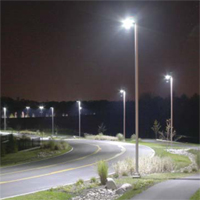
LED Street Lighting Field Test Results Published
Light-emitting diode (LED) technology continues to rapidly mature and is pursued as a street lighting alternative to traditional lamp sources categorized as high intensity discharge (HID) lamps, such as high pressure sodium luminaires. In order to quantify the performance of new LED street lighting options, lighting specifiers must compare the claimed benefits of LED fixtures, including long life, reduced maintenance, and energy savings, to existing HID sources.
The LRC recently released a new publication detailing field test evaluation results of an LED street lighting installation in a suburban business park in upstate New York. “Through real-world environment case studies, LRC’s DELTA program provides objective information regarding the performance and acceptance of products,” said Jennifer Brons, LRC research scientist and DELTA program manager.
In this recent case study, DELTA evaluated 16 Edge™ LED luminaires, manufactured and donated by BetaLED, lining a curved, three-lane street built to service a new office building in North Greenbush, N.Y. The mission was to examine and measure system performance, photometric performance, energy savings, light pollution and whether volunteers visiting the site accepted the LED street lighting system. The results are detailed in Field Test DELTA Snapshots: LED Street Lighting.
The Edge luminaires use a system of LED bars, each bar housing 20 high-output white LEDs. Based on the desired light output, lighting specifiers select the number of bars per luminaire. In this installation, the Edge luminaires have three LED light bars each and are mounted on poles 30 feet high and spaced 130 to 180 feet apart. DELTA compared the installation to a neighboring high pressure sodium (HPS) street lighting system in the same business park.
Study findings
- Most visitors considered the lighting to be, overall, the same as or better than other roadways at night.
- Relative to the neighboring HPS installation, the LED installation uses less power while providing better uniformity.
For complete details, a PDF version of the publication is available for free download at www.lrc.rpi.edu/programs/DELTA/pdf/FTDelta_LEDStreetLighting.pdf.
DELTA also recently field tested photovoltaic-powered LED luminaires installed at three public, outdoor sites in the Catskill Mountains region of upstate New York. The luminaires were prototypes designed by Sullivan Renaissance, Philips Hadco and SolarOne® Solutions. For complete details, a PDF version of the publication, Field Test DELTA: Post-Top Photovoltaic (PV) Pathway Luminaire, is available online at www.lrc.rpi.edu/programs/DELTA/pdf/DELTA-Post-topPhotovoltaic.pdf.
|
About the Lighting Research Center
The Lighting Research Center (LRC) is part of Rensselaer Polytechnic Institute of Troy, N.Y., and is the leading university-based research center devoted to lighting. The LRC offers the world's premier graduate education in lighting, including one- and two-year master's programs and a Ph.D. program. Since 1988 the LRC has built an international reputation as a reliable source for objective information about lighting technologies, applications, and products. The LRC also provides training programs for government agencies, utilities, contractors, lighting designers, and other lighting professionals. Visit http://www.lrc.rpi.edu. |



